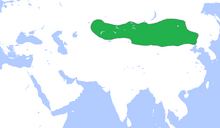The Ashina rebellion was a revolution that resulted in the establishment of the First Turkic khaganate and the fall of the Rouran state.
| Ashina Revolt | |||||||
|---|---|---|---|---|---|---|---|
| Part of Rise of Gokturks | |||||||
 | |||||||
| |||||||
| Belligerents | |||||||
| First Turkic Khaganate | Rouran Khaganate | ||||||
| Commanders and leaders | |||||||
| Bumin Qaghan | A-na-kuei † | ||||||
| Strength | |||||||
| Unknow | Unknow | ||||||
| Casualties and losses | |||||||
| Tiny or none | All Rourans were killed, enslaved or fled to China | ||||||
Reason for Revolt
editAfter a series of diplomatic relations, Bumin, the first known Turkic ruler, was officially recognized by the Western Wei state and subsequently annexed the Töles tribes. As a result, he began to see himself as equal to the Rouran state to which he belonged, and to prove this to the Rouran Khagan, he wanted to marry his daughter. For this purpose, he sent an envoy to the Rouran Khan and attempted to marry his daughter. The Rouran leader A-na-kuei rejected this proposal very strongly. He then sent a counter envoy and insulted Bumin by saying, "You are my iron-working slave, how dare you speak to me?". Thus he declared that he did not recognize Bumin as a power. Bumin killed A-na-kuei's envoy.[1][2]
Revolt
editIn the spring of 552, the Gokturk horsemen, moving from the southeast of the Altai mountains, crossed the Gobi desert and arrived north of the Huai-huang region outside the Great Wall of China, where they defeated A-na-kuei's army. Unable to bear the pain of defeat, A-na-kuei committed suicide and the Rourans dispersed. Bumin became Il-Kagan and his wife became Khatun. The Rourans were killed and enslaved, never to establish a state again.[1][2][3]
References
edit- ^ a b The Encyclopedia of Empire. John Wiley & Sons, Ltd. 2016. pp. 2127, 2128, 2129.
- ^ a b Taşağıl, Ahmet (2021). Göktürkler [Gokturks] (in Turkish). Istanbul: Bilge Kültür Sanat Yayınları. pp. 61, 62.
- ^ Ercilasun, A. Bican (2019). Türk Kağanlığı [Turkic Khaganate] (in Turkish). Istanbul: Dergah Yayınları. pp. 38, 39.